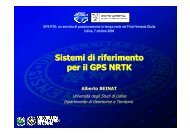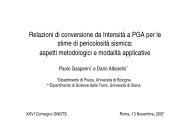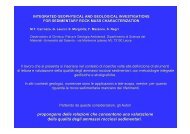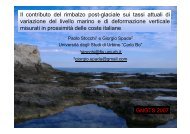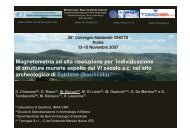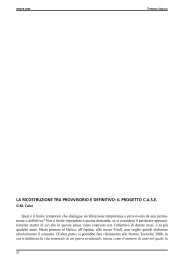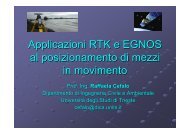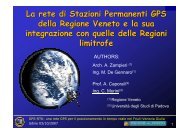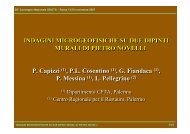Create successful ePaper yourself
Turn your PDF publications into a flip-book with our unique Google optimized e-Paper software.
GNGTS 2009 SESSIONE <strong>2.3</strong><br />
Fig. 1 - Area of interest with the surface<br />
projections of the main fault planes.<br />
have been calculated by means of numerical finite-source ground-motion simulations. A parametric<br />
study has been performed to identify the most critical rupture mechanisms for the ground response<br />
at Vicoforte.<br />
Numerical modelling has been carried out following two different approaches:<br />
• the deterministic method by Hisada and Bielak [2003] implemented by the GRFLT12S code for<br />
the low frequency range simulations (from 0 to 1÷2 Hz);<br />
• the stochastic method implemented in EXSIM code [Motazedian and Atkinson, 2005] for the high<br />
frequency range simulation (higher than 0.5÷1 Hz).<br />
The deterministic Hisada-Bielak method simulates the complete 3D wave propagation field<br />
induced by an extended kinematic source based on the static and dynamic Green functions. The high<br />
frequency EXSIM approach simulates the finite fault as a plane divided into a series of sub-faults,<br />
each one modelled as a stochastic point source, using a Brune (w 2 ) source spectrum. This program<br />
allows to simulate only the S-wave field. Prior to the numerical simulation of future ground shaking<br />
scenarios due to the activation of the identified faults, synthetic seismograms have been generated<br />
with reference to a well-documented historical earthquake. The Asti event of August 21, 2000<br />
of M w 4.86 was used as a reference. Although this earthquake is a low magnitude event, it has been<br />
selected since it is located on the plane of the Monferrato fault. Furthermore, numerous recordings<br />
on rock stations are available for this event. The GENL rock station of the Regional Seismic Network<br />
of North-western Italy (http://www.dipteris.unige.it/geofisica/) has been chosen for the calibration,<br />
being the nearest one to the fault and with an epicentral distance of about 65 km, close to<br />
the distance between this fault and Vicoforte site. Fig. 2 shows the satisfactory agreement achieved<br />
between recorded data and GRFLT12S simulations.<br />
To identify the worst potential ground shaking scenarios at Vicoforte site, three events have been<br />
selected, representing the most critical situation with reference to the expected average ranges of<br />
magnitude for the faults listed in Table 1:<br />
• Monferrato fault: event of M w =5.5, corresponding to a return period of about 690 years;<br />
• Western Alps fault: event of M w =5.7, corresponding to a return period of about 475 years;<br />
• Western Liguria fault: event of M w =6.5, corresponding to a return period of about 2475 years.<br />
The return periods have been evaluated in the framework of a probabilistic seismic hazard<br />
487




